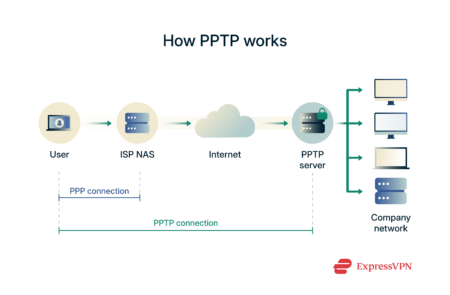Level-to-Level Tunneling Protocol (PPTP) is among the oldest VPN protocols nonetheless in use in the present day.
Nevertheless, in comparison with extra trendy options, like OpenVPN, WireGuard, and ExpressVPN’s proprietary Lightway protocol, PPTP is broadly thought of an outdated and insecure selection.
This information covers the origins of PPTP, the way it works, execs and cons, and whether or not it nonetheless holds any worth for the common VPN consumer in the present day.
What’s PPTP?
PPTP is a VPN protocol. Protocols are units of guidelines that management how a VPN features. They affect facets like safety and pace when establishing your VPN connection.
There are a number of VPN protocols to select from, and PPTP is among the oldest, having been round since Home windows 95.
On the time, companies wanted a manner for workers to connect with inside sources from outdoors the workplace utilizing dial-up web connections—which have been insecure and had no built-in privateness. PPTP got here in to resolve that by:
- Making a safe tunnel over the general public web,
- Utilizing PPP (Level-to-Level Protocol) for authentication and information framing,
- And wrapping it in Microsoft Level-to-Level Encryption for fundamental encryption.
Let’s take a better take a look at the way it works.
How does PPTP VPN work?
As talked about, PPTP was constructed primarily for distant employees to entry firm networks safely with no need bodily entry or costly leased strains. It wasn’t designed with private privateness in thoughts, in contrast to most trendy VPN protocols.
 Right here’s a step-by-step breakdown of how PPTP works:
Right here’s a step-by-step breakdown of how PPTP works:
- The consumer connects to the web: A consumer (for instance, somebody working from residence) connects to the web utilizing their native web service supplier (ISP). Again within the day, this could be by way of dial-up networking, however PPTP can be utilized over different web connections as nicely.
- Connection to the ISP’s community entry server (NAS): The consumer’s machine connects to a community entry server (NAS), which manages consumer connections on the ISP’s finish.
- PPP (Level-to-Level Protocol) hyperlink is established: A normal PPP connection is ready up between the shopper and the NAS, permitting the consumer to ship and obtain basic web visitors.
- A second digital name is remodeled the PPP hyperlink: Over the already established PPP connection, the consumer now initiates a second session, this time to the corporate’s PPTP server on a non-public LAN.
- Encapsulated information transmission begins: The info for this second connection is distributed as IP packets that encapsulate PPP frames. These encapsulated packets kind the VPN tunnel.
- PPTP tunnel is established: This second digital session kinds a PPTP tunnel between the consumer and the corporate’s PPTP server. Because of this tunnel, the distant employee can now securely entry recordsdata, apps, or techniques which can be usually solely accessible on the workplace.
It’s price noting that, in comparison with trendy VPN protocols, corresponding to OpenVPN and ExpressVPN’s Lightway, PPTP is extra of a rudimentary tunneling protocol than a completely fledged VPN protocol within the trendy sense, because it lacks any form of routing mechanism to ship information packets to their vacation spot.
PPTP VPN execs and cons
The PPTP VPN protocol has some advantages in particular use instances. Nevertheless, it additionally has a number of distinct drawbacks that outweigh its benefits in most different instances.
| Execs | Cons |
| ✅ Quick speeds | ❌ Poor normal of encryption |
| ✅ Runs on older machines | ❌ Weak authentication know-how |
| ❌ Struggles with firewalls | |
| ❌ Can not compete with trendy protocols | |
| ❌ Deprecated in some working techniques |
Benefits of utilizing PPTP
PPTP’s predominant attraction is its simplicity—it’s simple to arrange, even for non-tech-savvy customers, and is constructed into some working techniques, so there’s no want for additional apps. It’s additionally quick, since its outdated encryption doesn’t sluggish issues down a lot, and it’s light-weight sufficient to run easily on older or low-powered gadgets. Nevertheless, trendy protocols like Lightway supply comparable ease of use and higher efficiency—with out compromising on safety.
Disadvantages of PPTP
- Weak encryption: PPTP depends on Microsoft Level-to-Level Encryption. MPPE makes use of the RC4 stream cipher, which was as soon as fashionable however is now thought of cryptographically damaged attributable to a number of vulnerabilities.
- Poor authentication: The implementation of MPPE with RC4 is very weak when paired with MS-CHAPv2, the authentication protocol utilized in PPTP. MS-CHAPv2 may be cracked in minutes, giving attackers entry to the encryption keys.
- Firewall points: PPTP makes use of GRE (generic routing encapsulation), a protocol that many firewalls block by default. This will make PPTP difficult or impossible to use behind strict firewalls or network address translation (NAT) devices.
- Deprecated: Whereas PPTP was as soon as broadly supported, it’s now deprecated on most main platforms attributable to safety considerations. For instance, Apple eliminated native assist in macOS and iOS, and plenty of VPN suppliers now not supply it.
- Lacks further security measures: Trendy VPN protocols supply extra superior security measures to guard customers. Many assist perfect forward secrecy (PFS), for instance, which helps to make sure that even when one encryption secret’s cracked or compromised, previous and future communications will nonetheless be safe as a result of every session makes use of a brand new key. PPTP, in distinction, doesn’t assist PFS.
What’s PPTP passthrough, and when is it wanted?
PPTP passthrough is a function current in some router fashions, particularly older ones. Its goal is to permit PPTP VPN visitors to “move via” firewalls and NAT gadgets, which might in any other case block it. In different phrases, it lets PPTP connections journey via the router with none restrictions.
This function is just helpful in case you’re utilizing PPTP and encountering points with firewalls or NAT.
PPTP vs. different VPN protocols: An entire comparability
Subsequent, let’s check out how the PPTP VPN protocol matches as much as different protocols, like OpenVPN or IKEv2.
PPTP vs. OpenVPN
OpenVPN is among the hottest and broadly used VPN protocols in the present day. It’s open-source, that means its code is freely accessible for anybody to examine, audit, and even modify. A number of unbiased safety audits have confirmed that OpenVPN is a safe and dependable protocol.
In comparison with PPTP, OpenVPN provides a lot stronger safety with its sturdy encryption, safe authentication, and ahead secrecy.
PPTP vs. L2TP/IPSec
L2TP, or Layer Two Tunneling Protocol, works together with the IPSec safety protocol to determine safe VPN connections. The L2TP protocol handles the connection and tunneling, whereas IPSec does the encryption.
That is fairly an outdated protocol, much like PPTP, and the 2 are equally easy to arrange and work with. L2TP/IPSec is often safer, as IPSec provides as much as 256-bit encryption, and it’s extra secure. That mentioned, there are a number of trendy protocols which can be higher by way of safety than each PPTP and L2TP/IPSec.
PPTP vs. IKEv2
Internet Key Exchange version 2 (IKEv2), like L2TP, is a VPN protocol that works along with the IPSec safety protocol. IKEv2/IPSec is among the mostly used VPN protocols, due to its sturdy ranges of efficiency in facets like pace, safety, and stability, and it really works significantly nicely on cellular gadgets, as it may shortly reconnect when switching from Wi-Fi to cellular information and vice versa.
In distinction to PPTP, IKEv2/IPSec implements stronger encryption and superior authentication, so it does a a lot better job of maintaining your information secure. And regardless of the bigger encryption overhead, IKEv2/IPSec isn’t slower than PPTP. It’s additionally extra secure on the entire.
PPTP vs. WireGuard
WireGuard is one other fashionable VPN protocol, bearing some similarities to OpenVPN. It’s open-source and has been independently audited, with none main points detected. WireGuard can be identified for being lean and light-weight, made up of simply over 7,000 strains of code. Because of this, it’s very simple to work with.
The lean and light-weight nature of WireGuard additionally offers it a pace benefit over PPTP. Plus, it makes use of the 256-bit ChaCha20 encryption algorithm, which is superior to PPTP’s encryption in each manner. Total, WireGuard is safer, extra secure, and way more dependable than PPTP.
When (and why) would you continue to use PPTP?
Given its many flaws, coupled with the truth that there are plenty of easier and higher VPN protocols on the market, you may surprise if there may be actually any level to utilizing PPTP. Or any state of affairs the place you may select to make use of this protocol in any respect?
We don’t advocate utilizing PPTP when you might have different choices—particularly trendy protocols like Lightway and WireGuard which can be safe, quick, and straightforward to arrange. However in case you’re utilizing older gadgets that don’t have entry to the most recent and biggest in VPN protocol know-how, PPTP remains to be higher than nothing. It is going to present some degree of safety and privateness to your on-line connections, and a few networks nonetheless depend on it as a result of it’s easy to arrange and appropriate with legacy techniques.
FAQ: Frequent questions on PPTP VPN protocol
Sure, PPTP is an outdated VPN protocol. It doesn’t have the identical requirements of safety and encryption as extra trendy protocols, corresponding to OpenVPN, WireGuard, and ExpressVPN’s Lightway.
Sure, you possibly can nonetheless use PPTP on trendy Home windows machines working the Home windows 10 or 11 working techniques. Nevertheless, it’s not advisable. Even Microsoft, creator of PPTP, recommends utilizing different, safer options.
These two protocols work in slightly different ways, with L2TP harnessing IPSec for encryption. This makes L2TP safer than PPTP, though each protocols have extra trendy options with higher safety.
As a result of it has quite a few security flaws in its encryption and authentication processes, and there are easier, safer choices on the market these days.
PPTP makes use of TCP port 1723 to determine and handle the management connection between the VPN shopper and server. For the precise transmission of VPN information (encapsulated PPP packets), it depends on GRE (Generic Routing Encapsulation—IP protocol 47).
PPTP can’t function over UDP—it strictly requires TCP and GRE. This mixture could make it extra vulnerable to points on networks that block GRE visitors.
One of the best VPN protocol will depend on your wants, however ExpressVPN’s Lightway, OpenVPN, and WireGuard are broadly considered prime selections for pace and safety.
PPTP is used to determine safe tunnels between consumer gadgets and VPN servers. Nevertheless, it isn’t used very much nowadays, as it’s thought of an outdated and insecure protocol.
Sure, PPTP does embody encryption, but it surely’s thought of outdated and insecure. It makes use of Microsoft Level-to-Level Encryption (MPPE), which helps 40-bit, 56-bit, or 128-bit keys and depends on the RC4 stream cipher. Whereas this was enough on the time of its launch, RC4 has since been discovered to have critical vulnerabilities, and the authentication technique PPTP usually makes use of—MS-CHAPv2—may be cracked comparatively simply. Due to these weaknesses, PPTP’s encryption is now not thought of secure for safeguarding delicate information.
OpenVPN is superior to PPTP in each manner. It’s way more safe, secure, and dependable, and it has far fewer vulnerabilities.
IPSec isn’t a standalone VPN protocol—it’s sometimes utilized in mixture with protocols like IKEv2, which is usually superior to PPTP by way of safety and stability.
PPTP makes use of the TCP port 1723 to determine a VPN connection.













